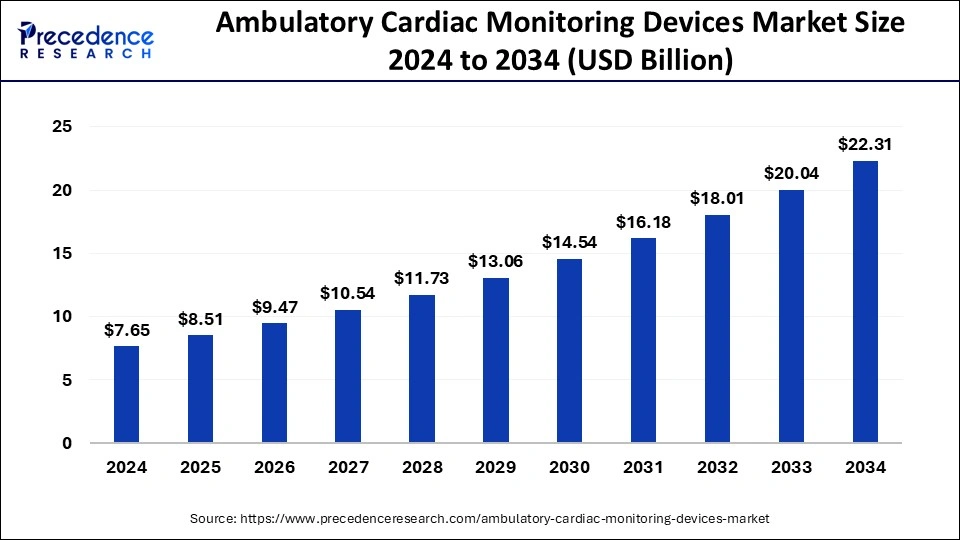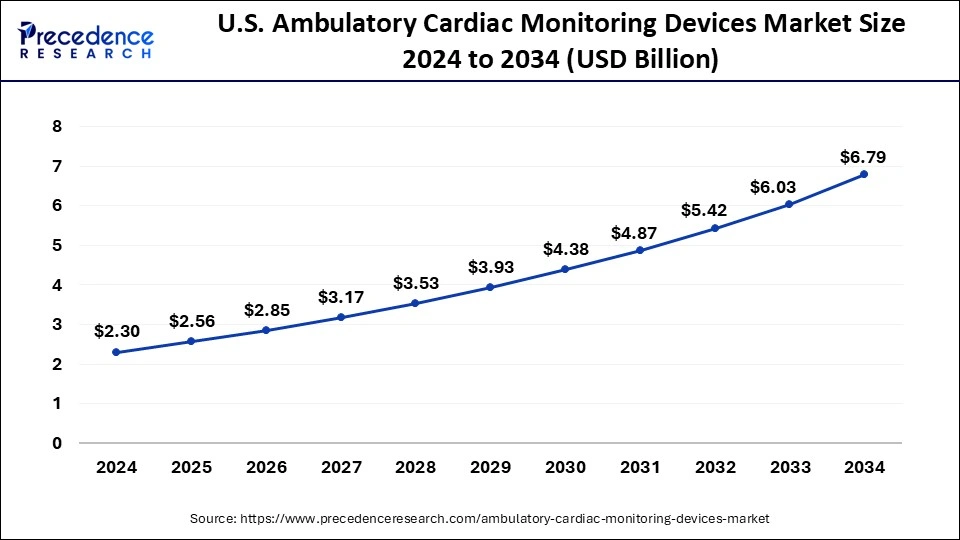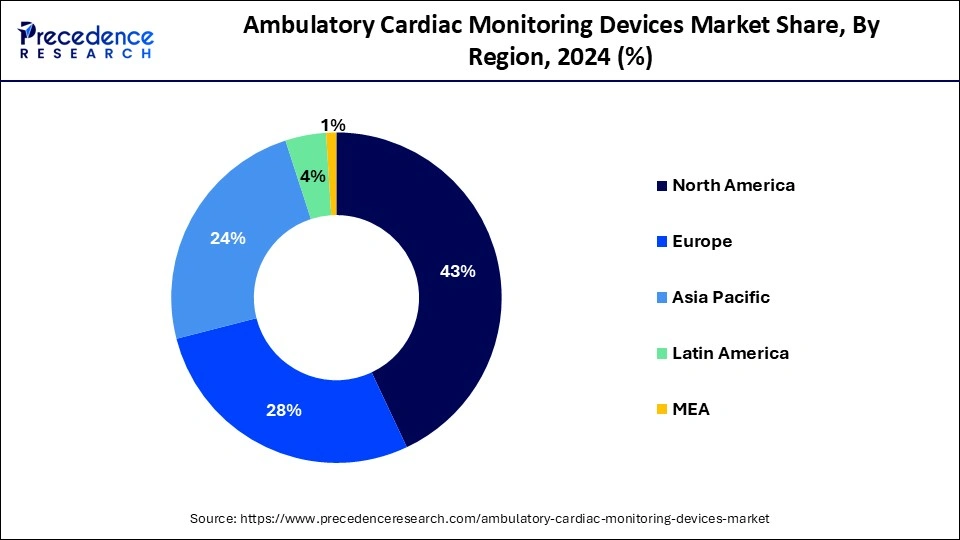September 2024
The global ambulatory cardiac monitoring devices market size is calculated at USD 8.51 billion in 2025 and is forecasted to reach around USD 22.31 billion by 2034, accelerating at a CAGR of 11.0% from 2025 to 2034. The market sizing and forecasts are revenue-based (USD Million/Billion), with 2024 as the base year.
The global ambulatory cardiac monitoring devices market size was estimated at USD 7.65 billion in 2024 and is predicted to increase from USD 8.51 billion in 2025 to approximately USD 22.31 billion by 2034, expanding at a CAGR of 11.30% from 2025 to 2034.

The U.S. ambulatory cardiac monitoring devices market size accounted for USD 2.30 billion in 2024 and is expected to be worth around USD 6.79 billion by 2034, growing at a CAGR of 11.43% from 2024 to 2034.

North America held the largest revenue share of 43% in 2024. North America dominates the ambulatory cardiac monitoring devices market due to several factors. It boasts a high prevalence of cardiovascular diseases, a rapidly aging population, and a well-established healthcare infrastructure. Moreover, robust research and development activities and early adoption of advanced medical technologies contribute to the region's market leadership. Favorable reimbursement policies and healthcare reforms further stimulate the demand for ambulatory cardiac monitoring devices. Additionally, strategic partnerships between device manufacturers and healthcare providers have bolstered market growth. All these factors combined make North America a major player in the ambulatory cardiac monitoring devices market.

Asia-Pacific is growing at a CAGR of 4.1% during the forecast period. The Asia-Pacific region commands a substantial growth in the ambulatory cardiac monitoring devices market due to several key factors. This region has witnessed a rising prevalence of cardiovascular diseases, driven by lifestyle changes and an aging population. Additionally, improving healthcare infrastructure, increasing healthcare expenditures, and growing awareness of cardiac health have fostered demand for advanced monitoring devices. Furthermore, the presence of a large patient population and expanding access to healthcare services in emerging markets within Asia-Pacific have contributed to its major market share. These factors collectively make the region a lucrative and high-growth market for ambulatory cardiac monitoring devices.
The ambulatory cardiac monitoring devices market pertains to the sector within the medical device industry that specializes in portable, wearable, or implantable gadgets crafted to track a patient's heart activity outside the usual clinical environments. These devices are indispensable for diagnosing and overseeing diverse cardiac ailments, such as arrhythmias and heart rhythm irregularities. The market has witnessed substantial growth due to rise in the incidence of cardiovascular diseases and the need for non-invasive, continuous monitoring solutions. Innovations in technology, such as encompassing wireless connectivity and remote monitoring capabilities, have further propelled market expansion, offering patients and healthcare providers valuable tools for early detection and enhanced cardiac healthcare.
The ambulatory cardiac monitoring devices market is a thriving sector in the realm of medical apparatus, specializing in the creation and dissemination of portable, wearable, and implantable instruments tailored to monitor cardiac activity in non-clinical environments. These devices hold a pivotal role in diagnosing and managing various cardiac conditions, including arrhythmias and heart rhythm irregularities, by offering continuous and non-intrusive monitoring solutions. The market's impressive growth is driven by a multitude of influential factors.
A significant trend within the sector pertains to the escalating prevalence of cardiovascular maladies, propelling the demand for ambulatory cardiac monitoring devices. As cardiac-related ailments become increasingly widespread, these devices take on a critical role by providing early detection and uninterrupted monitoring, empowering healthcare professionals to provide more precise diagnoses and timely interventions. Additionally, technological strides such as wireless connectivity and remote monitoring capabilities are reshaping the landscape. These innovations grant patients and healthcare providers’ access to real-time data, enhancing the quality of patient care and treatment outcomes.
The ambulatory cardiac monitoring devices market also faces distinct challenges. One notable hurdle is the intricate and stringent regulatory framework due to the critical nature of cardiac monitoring. Navigating the maze of regulatory approvals and compliance requisites can prove demanding and resource-intensive for manufacturers. Furthermore, the sector is marked by intense competition, leading to pricing pressures and necessitating perpetual innovation to uphold competitiveness.
Amidst these challenges, alluring business prospects materialize within this market. The increasing awareness regarding the significance of early cardiac condition detection and the pivot toward preventive healthcare presents substantial growth avenues. Manufacturers can explore collaborations with healthcare providers and insurers to furnish comprehensive cardiac monitoring solutions, tapping into a broader clientele.
Furthermore, venturing into emerging markets equipped with expanding healthcare infrastructure offers prospects for market expansion and global outreach. In summary, the ambulatory cardiac monitoring devices industry occupies a pivotal position in modern healthcare, spurred by the surging prevalence of cardiovascular diseases and breakthroughs in technology. While regulatory obstacles and competitive pressures persist, the market beckons with promising opportunities, including initiatives in preventive healthcare and potential global expansion, rendering it a dynamic and evolving segment within the domain of medical devices.
| Report Coverage | Details |
| Market Size in 2034 | USD 22.31 Billion |
| Market Size in 2025 | USD 8.51 Billion |
| Market Size by 2024 | USD 7.65 Billion |
| Market Growth Rate from 2025 to 2034 | CAGR of 11.30% |
| Dominating Region | North America |
| Fastest Growing Region | Asia Pacific |
| Base Year | 2024 |
| Forecast Period | 2025 to 2034 |
| Segments Covered | Device Type, End-use, and Region |
| Regions Covered | North America, Europe, Asia-Pacific, Latin America, and Middle East & Africa |
Rising cardiovascular disease prevalence
The surge in the prevalence of cardiovascular diseases (CVDs) serves as a pivotal impetus propelling the proliferation of the ambulatory cardiac monitoring devices industry. CVDs, encompassing ailments like arrhythmias, atrial fibrillation, and heart rhythm aberrations, have experienced a pronounced escalation in their ubiquity on a global scale. This pronounced upswing in CVD cases has engendered an exigent demand for cutting-edge cardiac monitoring solutions, with ambulatory monitoring devices taking the vanguard position in addressing this imperative need.
As the number of individuals diagnosed with or susceptible to CVDs continues its ascent, the importance of early detection and uninterrupted monitoring has attained unprecedented significance. Ambulatory cardiac monitoring devices offer a patient-centric, non-invasive modality for tracking cardiac activity over extended durations, facilitating the expeditious discernment of irregularities. Consequently, these devices wield a pivotal role in advancing patient care, constraining healthcare outlays, and elevating overall healthcare outcomes.
The burgeoning incidence of CVDs is instigating widespread assimilation of these devices among healthcare providers and patients, firmly establishing their stature as an indispensable constituent of contemporary cardiac healthcare. This prevailing trajectory is facilitating the sustained and robust expansion of the ambulatory cardiac monitoring devices industry.
Limited awareness and high costs
Limited awareness and high costs pose substantial impediments to the ambulatory cardiac monitoring devices industry growth. Insufficient knowledge among healthcare professionals and patients about the advantages and availability of these monitoring devices constrains their adoption. Many individuals and even some medical practitioners may lack comprehensive information about the merits of continuous cardiac monitoring in contrast to conventional methods. This lack of awareness can lead to underutilization and missed opportunities for early detection and intervention.
Furthermore, the elevated expenses associated with ambulatory cardiac monitoring devices create a formidable barrier to access. Patients may encounter financial constraints in acquiring these devices, even when covered by insurance. Additionally, healthcare facilities may exhibit reluctance in investing in costly equipment, particularly in resource-constrained settings.
The overall cost of ownership, inclusive of maintenance and data analysis, can become onerous. Mitigating these challenges necessitates targeted efforts in educational and awareness campaigns to enlighten healthcare providers and patients alike about the value of these devices. Additionally, innovations aimed at cost reduction and enhancing affordability are imperative to expand the market's reach.
Partnerships and collaborations
Partnerships and collaborations are fostering significant opportunities within the ambulatory cardiac monitoring devices industry. By joining forces with healthcare providers, insurers, and other stakeholders, device manufacturers can create comprehensive cardiac care solutions that cater to the diverse needs of patients and providers. These collaborations can facilitate bundled services that encompass device provision, continuous monitoring, and timely treatment. This integrated approach not only enhances patient care but also streamlines the healthcare delivery process, reducing administrative burdens and costs.
Moreover, partnerships enable access to a broader customer base and market reach. Device manufacturers can leverage the established networks and customer relationships of healthcare providers to introduce their monitoring solutions to a wider audience. In the era of value-based care, collaborations also support the shift towards outcome-driven healthcare. By aligning incentives and sharing data, stakeholders can work together to improve patient outcomes and reduce healthcare costs, which is particularly relevant in the management of cardiac conditions. Overall, partnerships and collaborations are instrumental in shaping the future of ambulatory cardiac monitoring, creating opportunities for innovation and improved patient care while strengthening the market presence of device manufacturers.
Impact of COVID-19
The COVID-19 pandemic has had a mixed impact on the ambulatory cardiac monitoring devices industry. While the initial disruption in the healthcare sector led to delays in elective procedures and reduced patient visits, it also accelerated the adoption of telemedicine and remote monitoring, driving the demand for ambulatory cardiac monitoring devices. As healthcare systems adapted to remote care delivery, these devices played a crucial role in ensuring continuous cardiac monitoring for patients while minimizing in-person visits. This shift in healthcare delivery and the increased focus on home-based care are expected to have a lasting positive impact on the market's growth and innovation.
According to the device, the ECG devices sector has held 38% revenue share in 2024. The ECG (Electrocardiography) devices segment's prominent market share within the ambulatory cardiac monitoring devices sector can be attributed to its extensive utility in cardiac diagnostics. ECG devices provide real-time, non-invasive heart activity monitoring, rendering them indispensable for detecting arrhythmias and heart rhythm irregularities. Their versatility, cost-efficiency, and accessibility to both healthcare providers and patients contribute to their dominance. Moreover, continual innovations in ECG technology, such as the emergence of portable and wireless alternatives, have further propelled their adoption. Consequently, ECG devices maintain a central role in cardiac monitoring, substantively bolstering the segment's market dominance.
The mobile cardiac telemetry (MCT) segment is anticipated to expand at a significantly CAGR of 13.7% during the projected period. The mobile cardiac telemetry (MCT) segment holds a significant growth in the ambulatory cardiac monitoring devices market due to its capability to provide continuous, real-time monitoring of a patient's heart activity for an extended duration. MCT devices offer high diagnostic yield, making them a preferred choice for identifying intermittent cardiac arrhythmias and other heart rhythm disorders. Their user-friendliness and ability to transmit data remotely align with the growing trend of telemedicine and remote patient monitoring. Consequently, MCT devices have gained prominence among healthcare providers, contributing to their major growth in the market.
In 2024, the hospitals & clinics segment had the highest market share of 51% on the basis of the End-use. The hospitals and clinics segment commands a significant share in the ambulatory cardiac monitoring devices market due to several key factors. Hospitals and clinics are primary healthcare settings where patients receive diagnoses and treatments for various cardiac conditions. These facilities rely heavily on advanced monitoring solutions to provide accurate assessments and timely interventions. Additionally, the presence of skilled healthcare professionals and the need for continuous monitoring during in-patient care contribute to the dominance of this segment. The integration of ambulatory cardiac monitoring devices into hospital and clinic workflows further solidifies their prominent role in cardiac care, leading to a major market share.
The ambulatory care centers segment is anticipated to expand at the fastest rate over the projected period. Ambulatory care centers have witnessed substantial growth in the ambulatory cardiac monitoring devices market due to their pivotal role in contemporary healthcare. These centers offer a convenient, cost-effective setting for patients to access cardiac monitoring services without the necessity of hospital admission. They facilitate the early identification, diagnosis, and treatment of cardiac ailments.
Furthermore, ambulatory care centers are increasingly incorporating advanced monitoring devices, aligning with patients' growing preference for non-invasive and outpatient care options. This evolving trend, coupled with the escalating prevalence of cardiovascular diseases, has propelled the demand for ambulatory cardiac monitoring devices in this healthcare context, thus solidifying their significant market growth.
By Device Type
By End-use
By Geography
For inquiries regarding discounts, bulk purchases, or customization requests, please contact us at sales@precedenceresearch.com
No cookie-cutter, only authentic analysis – take the 1st step to become a Precedence Research client
September 2024
March 2025
November 2024
February 2025